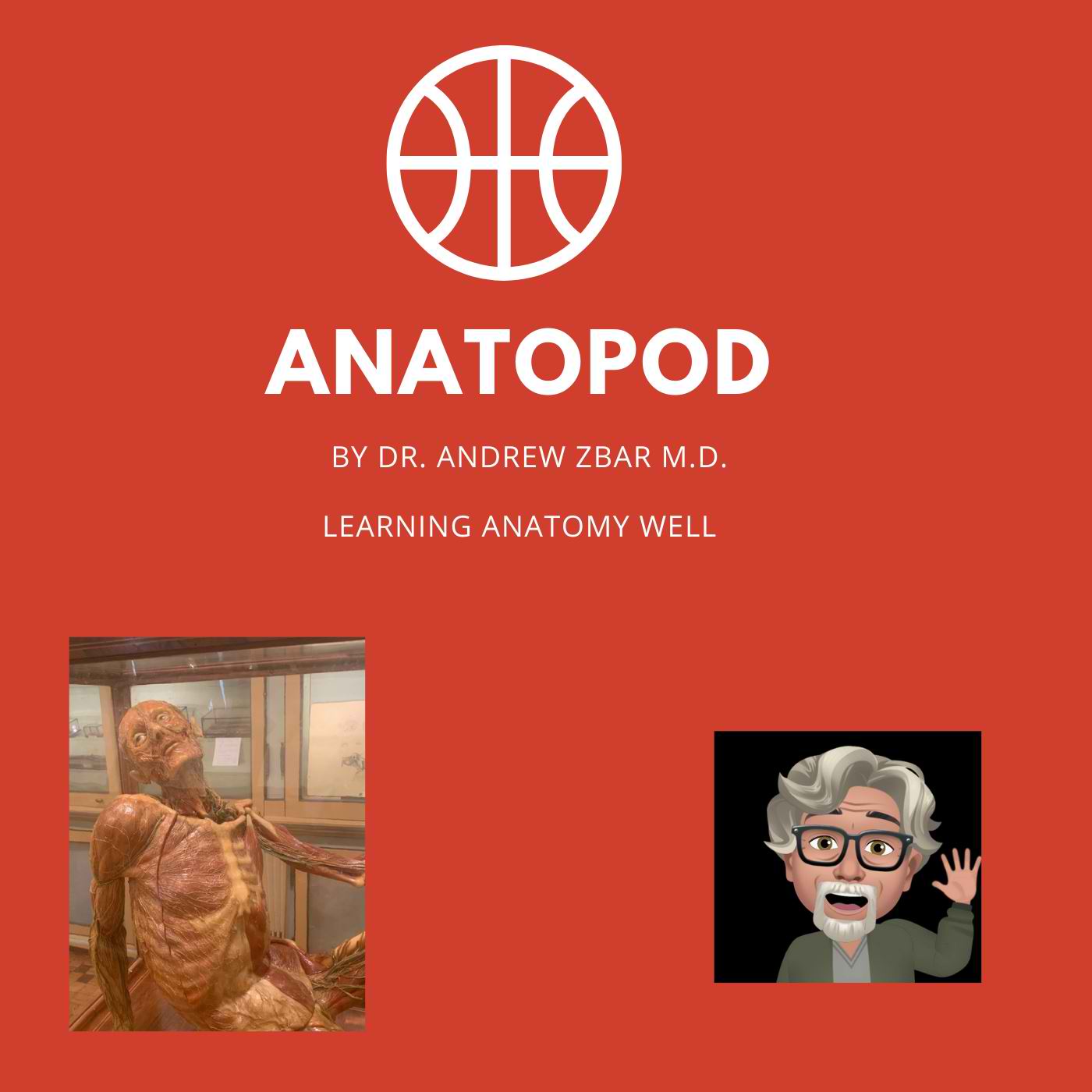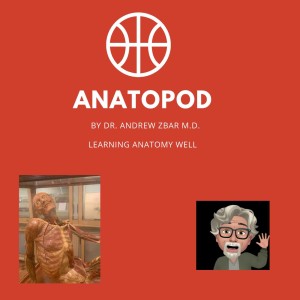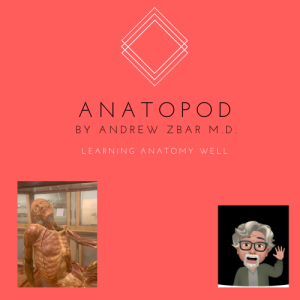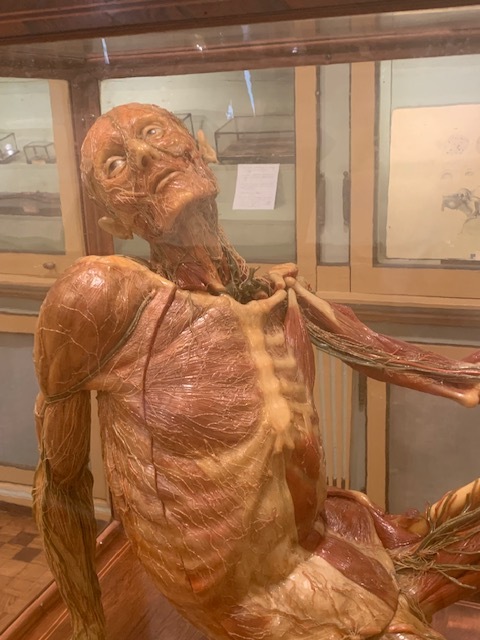
23.2K
Downloads
91
Episodes
Welcome to a new and exciting Podcast called ANATOPOD designed to teach anatomy. ANATOPOD aims not just to teach anatomy well to a high and practical level but also to introduce the history of anatomy and dissection of the cadaver. I appreciate that anatomy is a visual tradition but it wasn't always like that. In the Renaissance, anatomy was taught from textbooks written by the Greek Galen in the first century A.D. Perhaps it might seem unusual to revert anatomy teaching to an aural basis but it is recognized too that in this modern age anatomy departments in universities all over the world are dispensing with their raision d’être, the cadaver, replacing it with surrogates and models. We still do not know the effects of this change on the care of our patients but what we do know is that the cadaver is part of our death culture as much as it touches so many other aspects of society at large.
Episodes

Tuesday Feb 02, 2021
Tuesday Feb 02, 2021
PART 1: The Anatomization of Art: Anatomic Realism and the Dissecting Habits of Leonardo and Michelangelo
This is the next in the History of Anatomy section of ANATOPOD….
It discusses the differences between the personalities of Leonardo da Vinci (1452-1519) and Michelangelo Buonarroti (1475-1564) and how these differences governed the use of the cadaver in the betterment of their art.
Part 1 begins the discussion on Leonardo and his world view (his Weltanschauung) as well as the inspirations to his work by the goldsmith Lorenzo Ghiberti (1378-1455) and the architect of the Reniassance Leon Battista Alberti (1404-1472).
If one imagines art and anatomy like a Venn diagram, the subsets under consideration would only minimally overlap and caught within the penumbra of that intersection are the relatively rare examples of artists whom we are fairly certain dissected the cadaver (Antonio Pollauiolo, Luca Signorelli, Leonardo, Michelangelo, Rosso Fiorentino, Jacopo da Pontormo, Jacopo Tintoretto, Vincenzo Danti, Alessandro Allori, Pietro Francavilla). On the other side are the anatomists who illustrated their own work (Frederik Ruysch, Antonio Scarpa, John and Charles Bell, Henry Vandyke Carter, Frank Netter). Artist and art chronicler Giorgio Vasari (1511-74) singled out his favoured artisans Leonardo and Michelangelo, both symbols of a perfected
skill, one in perspective and the other in marble whose brief was not only the emulation of the visible Nature but who were men capable of surpassing Nature herself. Both artists would argue through their working lives over the supremacy of their favoured medium (painting or sculpture) but regardless of which reigned as the better channel conveying beauty, both had embodied the finest executions of the human form with an almost Divine grace.
Part 2 differentiates how Michelangelo dissected through need but Leonardo because of passion. Michelangelo dissected his bodies for their myology but obsessed with function as much as form Leonardo examined them for their own sake. Leonardo’s anatomical imagery seems to have been produced more for his own edification than anything else. Michelangelo, however, used anatomy as a democratizing force. No less touched by a Divine Grace, the sculpted products that profited by his dissections of the corpse were unguarded tactile encounters specifically designed for the masses.

Sunday Jan 24, 2021
ANATOMY AND OSTEOLOGY OF THE SKULL, THE SKULL FORAMINAE AND THE SCALP
Sunday Jan 24, 2021
Sunday Jan 24, 2021
AHN 5: The basic osteology of the skull is considered along with the boundaries and division of the cranial cavity into the anterior, middle and posterior cranial fossae. The foraminae and their contents are discussed as are the individual bones and their ossification.
Includes: Occiptal, Temporal, Sphenoid, Parietal,Frontal, Ethmoid and the Palatine bones. The anatomy of the scalp and its neurovasculature are considered as is the temporal fossa and the Gillies approach to simple malar and zygomatic arch fracture.
The next podcast (AHN 6) discusses the Cranial Nerves and the Brainstem Nuclei.

Tuesday Jan 19, 2021
The Beginnings of Autopsy History of Anatomy (3)
Tuesday Jan 19, 2021
Tuesday Jan 19, 2021
From the earliest record by Fra Salimbene of an autopsy in 1286, the postmortem examination became the new method of estimating the cause of death. But the rise of autopsy and its social acceptance allowed the anatomists to dissect the human body for inquisitive means. In some cases like Boniface VIII it irked the Pope so much that he issued his decretal the Detestande feritatis Bull in 1299 prohibiting the separation of bodies, which was a method used to preserve the bones of Crusaders. But other Popes like Benedict XIV very much favoured the practice of examination of the corpse in the furthering of the understanding of the physical world. For Benedict (who issued his Notificazione in 1737) dissection of the human body was a powerful way to come to understand the mind of God. The rival cities of Bologna and Padua set up their theatrae anatomia, dissecting halls dedicated to dismantling corpses and their styles governed the public spectacles of dissection for the next 200 years. In this podcast the story of autopsy is considered through its headiest days and to its ultimate modern decline.

Thursday Jan 07, 2021
AHN 4 THE AUTONOMIC NERVOUS SYSTEM AND THE GANGLIA
Thursday Jan 07, 2021
Thursday Jan 07, 2021
Description of the infrastructure of the Autonomic Nervous System of the Head and Neck
Sympathetic Nervous System and Horner's Syndrome
The Parasympathetic Nervous System Structure (Nucleus, Preganglionic pathways, ganglia, postganglionic pathways and the target tissues)
The 4 Head and Neck Ganglia (Ciliary, Submandibular, Pterygopalatine and Otic)

Sunday Dec 27, 2020
ANATOPOD AHN 3 The Prevertebral and Scalene Muscles and the Cervical Plexus
Sunday Dec 27, 2020
Sunday Dec 27, 2020
This podcast discusses the anatomy of the sternocleidomastoid muscle and the trapezius as well as the spinal accessory (XI) nerve. The levator scapulae, scalenii (and their relations), the other prevertebral muscles (longus colli, longus capitis and rectus capitis major) are also considered as is the subclavius. The architecture of the cervical plexus is discussed.

Sunday Dec 20, 2020
AN ILLUSTRATED HISTORY OF ANATOMY - AN OVERVIEW
Sunday Dec 20, 2020
Sunday Dec 20, 2020
This podcast provides an overview of how anatomy became illustrated beginning with Vesalius who conducted dissections himself and who inveigled the artist Jan Stephan van Calkar to provide exquisite illustrations. With this move anatomy switched from an aural to a new visual tradition and in allowing students to perform their own dissections it democratized anatomy as it acquired a new scientific method through the simple powers of observation. Although the artist and anatomist were looking at the same thing, their imperatives differed, anatomists striving for a precision and artists embellishing their work with an individual panache. By the mid-18th century when most of the macroscopic (so-called gross) anatomy had been discovered, the artists and the anatomists began to mutually drift apart and the art of anatomic illustration settled into a detached and dispassionate banality.

Monday Dec 07, 2020
The History of Anatomy Introduction 2nd Part
Monday Dec 07, 2020
Monday Dec 07, 2020
We continue with the second part of the introduction to the history of anatomy and the dissection of the human cadaver. This indeed is the story of anatomy's leading protagonist, the cadaver and of its willing or unwilling dissection in the discovery of the interior of the body. In this introduction I touch on how the Renaissance spirit made its way albeit reluctantly toward the anatomists, why the artists needed to dissect bodies and what was the nature of the Vesalian revolution. The podcast series and its relevant topics are outlined. These include: A brief history of illustrating the corpse, the beginnings of autopsy and the influence of the Papacy, the perfected anatomic realism and the dissecting habits of Leonardo da Vinci and Michelangelo Buonarroti, the nature of the Vesalian revolution in dissection, the birth of science and the philosophy of anatomy, Rembrandt and the anatomy paintings of the Dutch Golden Age, Frederik Ruysch and the preservation of a secret, the Kabinets of curiosity and the establishment of the public museum space, the sibling rivalry of the Hunter Brothers, the genesis of the Anatomy Act of 1832 and the traffic of corpses to the medical schools, the dissecting methods of Henry Gray, Röentgen’s Rays and the new ways of seeing, the BodyWorlds exhibition of Gunther von Hagens and the Artistes Macabre and the genderization of Anatomy.
Hmmm... that's quite a lot! So let's get started!

Sunday Nov 29, 2020
ANATOPOD - INTRODUCING A NEW ANATOMY PODCAST
Sunday Nov 29, 2020
Sunday Nov 29, 2020
This Podcast introduces ANATOPOD - the first podcast designed to teach anatomy to a high level. Following this introductory podcast the weekly series will move to the detailed anatomy of the Head and Neck and Neuroanatomy as well as adding podcasts on the history of anatomy and cadaveric dissection.

Sunday Nov 29, 2020
HISTORY OF DISSECTION OF THE CADAVER
Sunday Nov 29, 2020
Sunday Nov 29, 2020
We begin with an overview of the history of cadaveric dissection and the beginnings of anatomy as a discrete discipline. Since the traveling Body Worlds Show of Gunther von Hagens there has been a resurgence of public interest in the cadaver and its social impact. I outline the fascination with dissecting the human body and how I moved from life as a practicing surgeon to an anatomy tutor. This is the first introduction of a 2-part introductory podcast which chronologically outlines how the ritual of cadaveric dissection evolved and how the anatomy of the human body became illustrated. The second introductory podcast summarizes the beginnings of autopsy, the dissecting habits of Leonardo da Vinci and Michelangelo Buonarroti, the genius of Vesalius and the birth of science....and so much more.

Sunday Nov 29, 2020
Sunday Nov 29, 2020
This podcast covers the infrahyoid musculature layout and the anatomy and relations of the thyroid gland and the parathyroids along with the important surgical anatomy of the recurrent and external laryngeal nerves. In the second half of this podcast the surgical anatomy and operative surgical approach to the parotid and the submandibular gland are discussed. Some of the suprahyoid muscle arrangements are considered.
